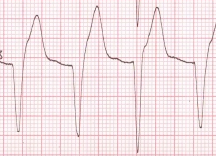Idioventricular Rhythms
Idioventricular Rhythms

Idioventricular rhythms (IVR) usually appear when the main pacemaker of the heart has slowed down or is non functional. Occasionally an accelerated idioventricular rhythm (AIVR) especially after successful thrombolysis of myocardial infarction, overrides the dominant pacemaker of the heart (sinus rhythm). Accelerated idioventricular rhythm is a classical reperfusion arrhythmia while usually IVR occurs in complete heart block (complete AV block). Continuous IVR decreases cardiac output due to the lack of atrial booster function and can cause syncope or near syncope. Treatment of IVR is aimed at increasing the heart rate to improve cardiac output and establishing sinus rhythm. Intravenous atropine can accelerate the sinus node to override the accelerated IVR. Rarely temporary pacing is needed to increase the heart rate. Transcutaneous pacer (non-invasive external pacemaker) can be used if the situation is urgent in order to tide over the situation and buy time while shifting the person for temporary transvenous pacing. An important point to be remembered is not to suppress idioventricular rhythm with drugs as it may lead to undue bradycardia.
Third complex in the ECG strip is either a capture beat or fusion beat because of the narrower QRS complex with slightly different morphology and a preceding P wave with a reasonable PR interval.
Agonal rhythm is an extremely slow form of idioventricular rhythm which is usually seen during resuscitation and is a near terminal rhythm. The complexes are wide possibly indicating severe myocardial damage.

